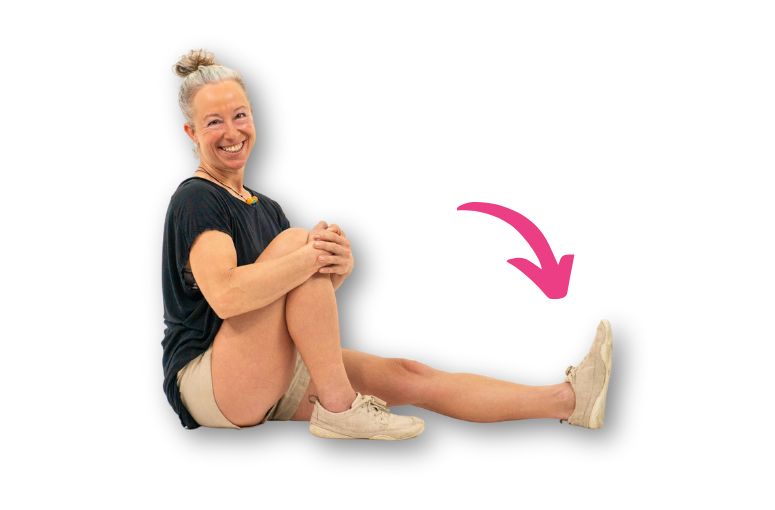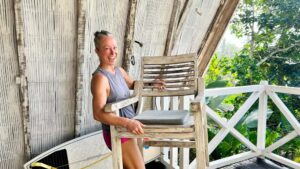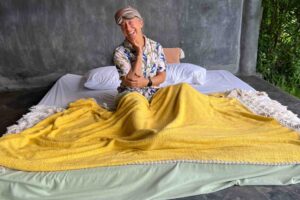Switching to minimal shoes can be a game-changer for your foot health, mobility, and overall movement quality. But making the switch isn’t as simple as tossing out your old shoes overnight – at least, not if you want to avoid unnecessary pain or injuries.
If you switch to minimal shoes too fast you can overload your feet, leading to discomfort or even injury. Just like any physical change, your body needs time to adapt.
That’s why it’s essential to plan your transition carefully.
Whether you’re currently experiencing foot pain, if you’re used to wearing conventional footwear or orthotics, or simply looking for the best way to transition safely, this guide will help you transition safely to healthier, more minimal shoes.
But First, What Are Minimal Shoes And Why Do You Need Them?
Conventional shoes aren’t designed with foot health in mind and prioritize fashion instead of function. Features like raised heels, narrow toe boxes and rigid soles can have huge (negative) effects on our foot health and overtime, lead to stiff, unhappy feet.
That’s where minimal shoes come in. Minimal shoes (also known as barefoot-style shoes) are lightweight, with zero-drop heels, a wide toe box, and thin, flexible soles that allow your feet to move, flex and function naturally.
Simply switching to minimal shoes can unlock a load of benefits like stronger feet, better balance, improved stability & coordination, and a more natural walking pattern – all of which reduce the risk of foot & ankle injuries.
(Looking for more information about minimal shoes and why you need them? Check out this post here.)
So yay for minimal shoes but making the switch can be a much bigger change for your body than you might expect. That means it’s a great idea to make a plan for a safe transition instead of just switching shoes and hoping for the best!
Before You Start Your Transition
Before you even begin changing your shoes, it’s a good idea to understand your personal starting point. This will help you plan the best transition for your needs.
A smooth & comfortable switch will depend on these four factors:
#1 The current state of your feet (e.g. are they pain-free, strong, stiff, weak, painful, diabetic?).
If your feet are already pain free and you spend time barefoot, you can probably transition faster than if you have an existing foot pain issue.
#2 The type of footwear you currently wear
Ask yourself how similar your current footwear is to minimal shoes – or how different (e.g. stiletto pumps or Birkenstocks)?
The closer to minimal shoes, the less time you will likely need to transition. So if your footwear is already fairly flat and flexible, you’ll likely be able to plan a fast transition.
However, if you’re currently using a lot of support and/or orthotics, you’ll likely take a bit longer.
#3 How you usually load your feet
Are you on your feet a lot? Or not very much. How challenging is the surface you walk on? Consider light walking, lots of walking, walking on pavement, hiking on challenging natural surfaces, running, etc.
This can go either way – if you’re already on your feet a lot, you may prefer a slower transition with more comfortable soles. For instance, the nurses I’ve worked with usually prefer thicker soled shoes for their transition!
However, if you’re on your feet actively a lot on natural surfaces your feet may already be quite strong, which will shorten your transition.
#4 How much exercise you are willing to do
Exercises will make your transition safer and help you get waaaayyy more benefit from switching.
Also, foot exercises can often be done while you do other things so they can be easy to fit into your day.
👉🏻 The more you support your transition with exercises, the faster you can expect to transition.
(Need some exercises to get you started? Try my (free) Free Your Feet program).
So how long will it take to switch to minimal shoes?
For a healthy person who’s not currently in pain and who doesn’t run or do a lot of heavy walking, expect to take about 8 weeks to switch.
If your feet & body are currently in pain, plan your transition to go slower – it could take a year or three.
Choose Your Path: 3 Ways To Transition
There are three basic ways to transition safely:
1️⃣ Go straight to very minimal shoes, but limit the amount of time you wear them. Build up gradually.
2️⃣ Choose transitional shoes that are similar to your current footwear. Over time, you’ll gradually increase the ‘barefootness’ of your shoe choices.
3️⃣ Try a hybrid approach – start with both a very barefoot option and a transitional option, and switch back and forth if it feels right for you.
(I’m a big fan of the third option – mostly because I don’t believe you’re going to want to wear your conventional, toe squashing shoes again once you get your feet in barefoot style shoes.)
All transitions are unique, but here are some guidelines for each path that work well for most people!
Path #1: Transition by moderating time
Best for: People without existing foot pain who are good at listening to their body
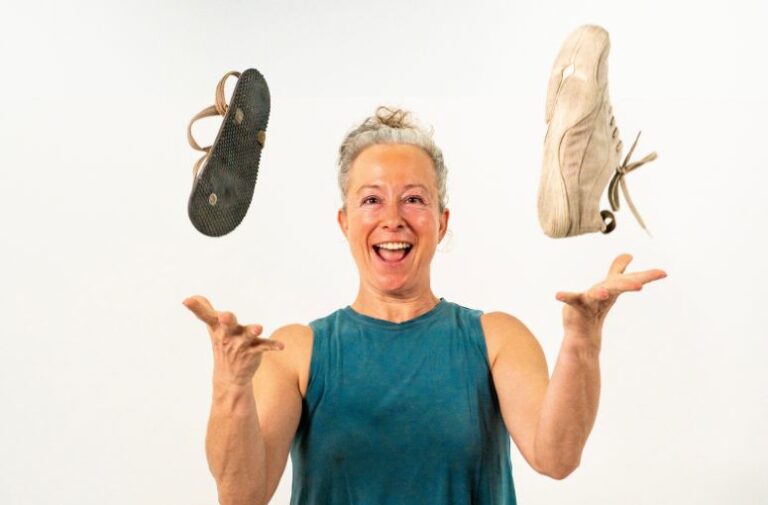
Transitioning safely to minimal shoes takes time – you should plan for at least 8 weeks to make the switch, but be prepared to go slower if it feels better for your body.
For week #1, start by wearing your minimal shoes for one hour per day of normal movement.
Then, from week #2 forward, add an hour every week until you’re wearing your minimal shoes all day every day.
Back off if your feet start to hurt or feel very tired at any point in this transition.
Go back to your other shoes for a few days or walk less, or a bit of both.
And be smart about it!
It’s really important to listen to your body as you transition. Don’t ignore pain, stiffness or soreness – these are often signals you’re taking it too fast for your body right now.
If your ‘one hour a day’ was sitting at your desk, then your ’two hours a day’ shouldn’t mean a two hour hike barefoot on gravel!!
For best results, support your transition with foot exercises to improve how your feet and body function. (The ones in my free Free Your Feet bootcamp were created for this exact purpose!)
Once you’ve transitioned, it’s a great idea to start adding time totally barefoot – try walking on different surfaces to continue improving your foot mobility & strength! Walking technique and happy feet go together like peanut butter and jam – they compliment each other and can’t really improve separately. So when you’re ready to move forward, check out my Build Better Feet program to help you nail walking and foot health at the same time!
Path #2: Transition using transitional shoes
Best for: People who currently have foot pain, people who don’t want to do foot exercises, people currently using orthotics

If you decide to go this route, start by choosing a pair of transitional shoes with soles that are about as thick as your current footwear, and start wearing them. This gradual shift will ease the strain on your feet, and if you currently wear orthotics, you can continue using them in your transitional shoes as you adapt.
Plan on taking a few weeks to ease into the transition by gradually increasing your time in your new shoes – play it by ear according to how your feet are feeling.
Make sure to work on foot exercises (like the ones in my free Free Your Feet program) so you can strengthen your feet as they adapt to your new footwear! This is a key step to prepare for wearing more minimal shoes later.
Wearing toe spreaders can also be really helpful for you because they help build really functional muscles in your feet and help restore circulation & alignment (which can help decrease pain).
I recommend CorrectToes because you can wear them in your shoes for more strengthening and muscle development. (And for more toe spacer recommendations, check out this post.)
If your feet respond by feeling better, then get a more minimal pair of shoes and start wearing them for a short amount of time daily. Increase this gradually – take at least 8 weeks.
If you experience more pain, back off, add more exercises, and consider getting personalised advice.
You may decide to never transition to a more minimal shoe – a transitional shoe is still going to give you huge benefits and this is really all about helping YOUR body feel its best!
Transitioning is unique to every person and usually involves some careful experimentation. Try new shoes, or time without your orthotics, for a short time. Then see how you feel the next day.
Allow your body to be your guide and don’t push through increased pain, it’s a sign that things aren’t working! But, don’t be scared to experiment with care and kindness.
Build strong, healthy, pain-free feet – for a lifetime! (for free!)
Path #3: A hybrid transition with both minimal and transitional shoes
Best for: People who want more foot-friendly options during their transition, works well with or without existing foot pain. Also anyone who has to manage high mileage, such as dog walkers. Or everyone.
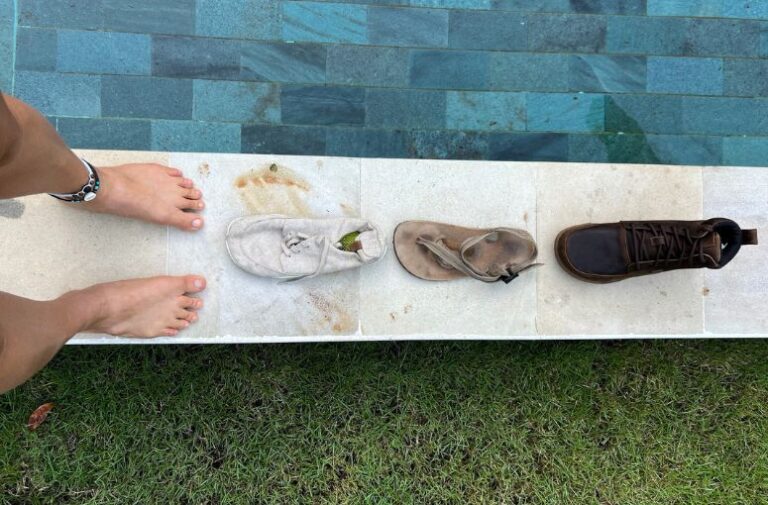
I think this is the best way for most people to transition, because this way you get the most foot-friendly options! Options are fantastic!
It’s pretty straightforward – just get yourself one pair of transitional shoes and one pair that’s more minimal.
On day one, try your transitional shoes for an hour. If that feels good, go two hours the next day, and build on from there for a week or two. Take longer if your feet prefer!
This is the most important time to do foot exercises, which will help strengthen and mobilise your feet to get ready for more minimal shoes.
(Need some foot exercises to support your transition? The exercises I chose for my (free) Free Your Feet program will help you restore your natural foot function faster and experience better results in the long term!)
Once your feet are happy in your transitional shoes, you can start switching right away to your more minimal shoes.
This time, plan for about 8 weeks, adding an hour or so each week. And use your transitional shoes as your alternative instead of your conventional shoes.
Pro tip: I often carry around a spare pair of shoes so I have an option if my feet don’t love what I’m doing to them that day. Yes, even 12 years in!
Other Important Considerations
#1 Listen to your body!
If you experience any pain or soreness, that usually means you’re going too fast. Take a few days in squishier shoes, walk a bit less, or do more exercises (the ones in my free Free Your Feet program were designed especially to support your transition!).
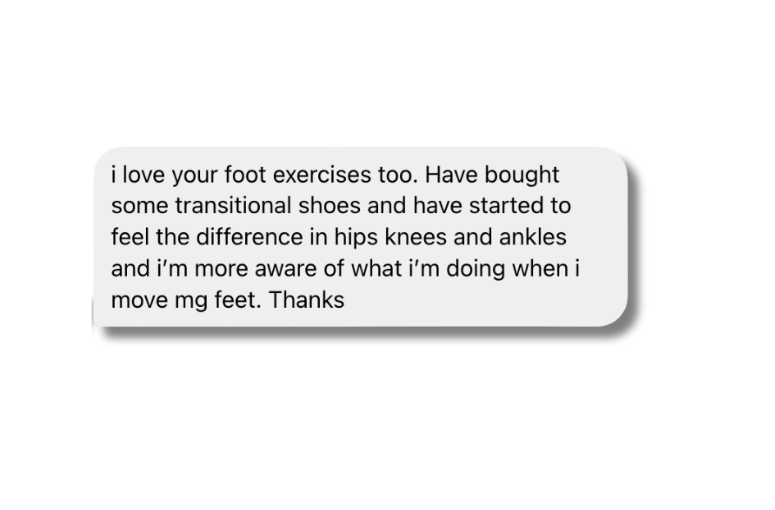
#2 Avoid making sudden, big increases to your movement
It’s surprisingly easy to overload your feet without realising it (until it’s too late).
Just because you’ve successfully transitioned to your normal daily activities does NOT mean your feet are now bulletproof.
Big increases in loads can damage any feet!
This includes longer-than-usual walks (especially on pavement or heavily textured natural surfaces), changing the texture you walk on (e.g. rocky hikes or long sandy beach walks), starting an intense new exercise program, or even switching to a standing desk.
For instance, your first big hike in the spring is a classic time to overdo things!
In fact, this is how I hurt my right foot during my own footwear transition.
I was already wearing barefoot shoes full time (about six months in). But it was the winter in Canada, so I wasn’t walking much.
And then I went on holiday to Mexico and insisted on walking barefoot on beach rocks. I triggered an injury that’s still with me today, almost 11 years later.
So, take it easy on new & challenging surfaces or with bigger distances at first. Give yourself more time than you think you need time to adapt, and use alternative shoes as needed!
#3 Add foot exercises & foot-related exercises
Simply switching barefoot style shoes will absolutely strengthen your feet. (In fact, research shows that wearing minimal shoes strengthens feet just as much as a foot exercise program!) My boyfriend is a great example – he transitioned without doing foot exercises and his feet feel great!
On the other hand, his toes are stiff and he doesn’t have great big toe alignment. Is that an issue for him? Only time will tell.
My firm opinion is that doing foot exercises as you transition will help you restore better strength, alignment and function faster and for the long term.
In fact, it’s not uncommon for me to hear from people who suddenly developed foot pain several years into their transition and who can’t figure out why.
I believe it’s because those are the people who would have benefitted from more foot work earlier in their journey.
Especially if you have an existing foot issue like plantar fasciitis or bunions, foot exercises will help you heal faster and get back to doing what you love soon!
And you’ll do even better if you consider exercises that help the body systems that are connected to your feet.
For example, tight calves and hamstrings (often caused by wearing shoes with heels) can negatively impact your walking patterns and contribute to long-term issues like neck & back pain that may not be changed simply by switching to barefoot style shoes.
To help get you started, here are a few of my go-to exercises that support not just your feet, but your entire body!
1️⃣ Calf stretch
3️⃣ Foot mobilization (especially useful for flat feet or high arches)
4️⃣ Finding hips over heels alignment
These are all foundational movements that will help restore alignment, improve foot function and make your transition to minimal shoes smoother and even more effective.
Switching to minimal shoes is an investment in your long-term foot health but unfortunately there’s no one-size-fits-all approach.
Whether you decide to ease in gradually, use transitional shoes, or take a hybrid approach, listening to your body is key. Try to avoid sudden increases in activity and don’t be afraid to take it slow and adjust your plan along the way.
And remember, minimal shoes are just one part of the equation. Supporting your transition with regular foot exercises, spending time barefoot, and exploring different textured surfaces will help you build resilient, adaptable feet that can handle the demands of real-world movement.
With patience and the right plan, I have no doubt you’ll experience stronger, more functional feet that allow you to move comfortably and confidently for years to come!

